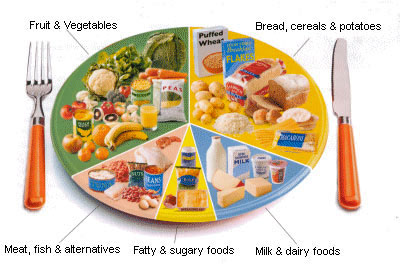

Healthy Eating Guide
Food is broken down into the following five accepted groups:
- Bread, cereals and potatoes
- Fruit and vegetables
- Milk and dairy foods
- Meat, fish and alternatives
- Fatty and sugary foods
To get a wide range of nutrients the body needs to remain healthy, it is important to choose various foods from the first four groups daily. Foods in the fifth group (fatty and sugary foods) are not essential to a healthy diet but add extra choice and taste. The proportion of each food group in the diet is shown by the different areas occupied by each food group on the plate in the diagram below.
This article does not apply to children under the age of five. If you are receiving medical supervision or special dietary needs, you should check with your doctor regarding your nutritional requirements.

Bread, other cereals and potatoes 
| Includes | Other cereals include breakfast cereals, pasta, rice, oats, noodles, maize, millet and cornmeal. Beans and pulses can be eaten as part of this group. |
| Nutrients | Carbohydrates (starch), Fibre, some calcium and iron, B Vitamins |
| How much | Eat lots |
| Try to eat | Wholemeal, wholegrain, brown or high fibre versions where possible |
| Try to avoid | Having them fried too often (e.g. chips) Adding too much fat (e.g. thickly spread butter or margarine on bread) Adding rich sauces and dressings (e.g. cream or cheese sauce on pasta) |
Fruit & Vegetables 
| Includes | Fresh, frozen and canned fruit and vegetables and dried fruit. Beans and pulses can be eaten as part of this group. A glass of fruit juice or blended fruits can also contribute. |
| Nutrients | Vitamin C, Carotenes, Folates, Fibre and some carbohydrate |
| How much | Eat lots. |
| Try to eat | A wide variety of fruit and vegetables. |
| Try to avoid | Adding fat or rich sauces to vegetables (e.g.
carrots glazed with butter, roast parsnips) Adding sugar or a syrupy dressing to fruit (e.g. stewed apple with sugar) |
Milk & dairy foods 
| Includes | Milk, cheese, yoghurt and fromage frais. This group does not include butter, eggs and cream. |
| Nutrients | Calcium Protein, Vitamin B12, Vitamins A and D |
| How much | Moderate amounts and choose lower-fat versions whenever you can. |
| Try to eat | Lower fat versions mean semi-skimmed or skimmed
milk, low fat (0.1% fat) yoghurts or fromage frais, and lower fat cheeses (e.g.
Edam, Half-fat Cheddar, Camembert) Check the amount of fat by looking at the labels' nutrient information. Compare similar products and choose the lowest. (e.g. 8% fat fromage frais may be labelled low fat but is not the lowest available) |
Meat, fish and alternatives
| Includes | Meat, poultry, fish, eggs, nuts, beans and
pulses. Meat includes bacon, salami, and meat products such as sausages, beef burgers, and pate. These are all relatively high-fat choices. Beans, such as canned baked beans and pulses, are in this group. Fish includes frozen and canned fish such as sardines, tuna, fish fingers, and fish cakes. |
| Nutrients | Iron, Protein, B Vitamins - especially B12, Zinc and Magnesium |
| How much | Eat moderate amounts and choose lower-fat versions whenever you can. |
| Try to eat | Lower fat versions mean meat with
the fat cut off, poultry without the skin and fish without batter. Cook these foods without added fat. Beans and pulses are good alternatives to meat as they are naturally very low in fat. |
Fatty and sugary foods 
| Includes | Margarine, low fat spread, butter, other spreading fats, cooking oils, oily salad dressings or mayonnaise, cream, chocolate, crisps, biscuits, pastries, cake, puddings, ice- cream, rich sauces and fatty gravies, sweets and sugar. |
| Nutrients | Some vitamins and essential fatty acids but also a lot of fat, sugar and salt |
| How much | Eat fatty and sugary foods sparingly - infrequently and in small amounts. |
| Try to eat | Some foods from this group will be eaten
daily but should be kept to small amounts. (e.g. margarine, low fat
spread, butter, other spreading fats, cooking oils, oily salad dressings or
mayonnaise) Other foods from this group are occasional foods. (e.g. cream, chocolate, crisps, biscuits, pastries, cake, puddings, ice-cream, rich sauces and fatty gravies, sweets and sugar) |
How much do we need?
The number of calories we require will vary from one individual to another, but the proportions of food from the different groups should remain the same.
The factors that affect people's daily energy requirements are:
- Gender - women tend to need fewer calories than men
- Age - older adults need fewer calories than adolescents and young adults
- Overweight - being heavier than their ideal weight means fewer calories are required to achieve a healthy weight
- Physically active - the more active a person is, the higher their calorie needs
Vitamin and mineral supplements
You can get all the vitamins and minerals your body requires daily by having various foods in your diet.
Women who are already or planning to become pregnant may need additional folic acid and or iron, and older adults may need extra Vitamin D and or iron. Your doctor will advise if you require other Vitamin and mineral supplements.
Page Reference
If you quote information from this page in your work, then the reference for this page is:
- MACKENZIE, B. (2002) Healthy Eating Guide [WWW] Available from: https://www.brianmac.co.uk/eating.htm [Accessed